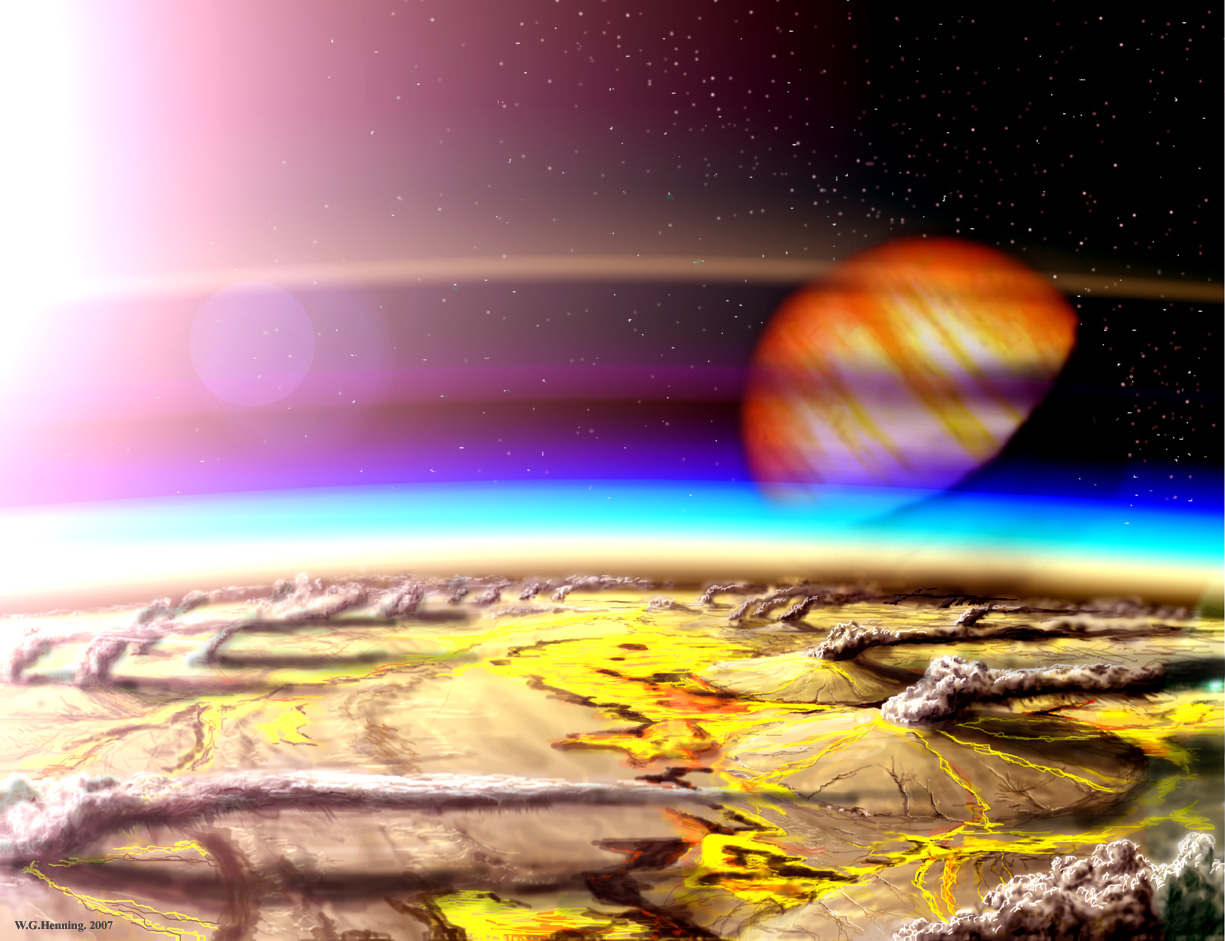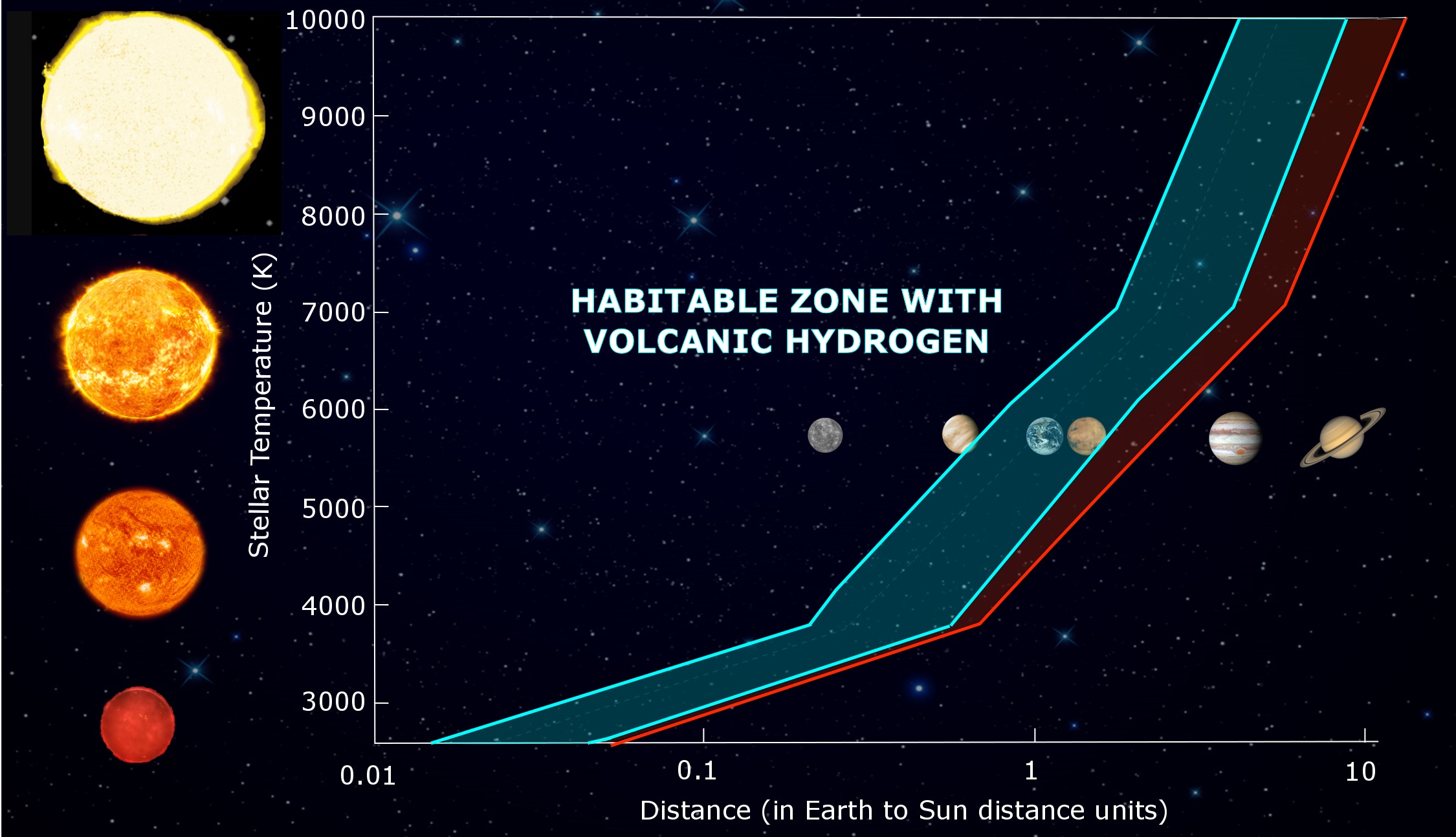Volcanoes Could Make Some Alien Planets Warm Enough for Life

Hydrogen-spewing volcanoes could boost the temperatures of seemingly frigid alien planets enough to maintain liquid water on their surfaces, making the worlds potentially habitable to life as we know it, a new study suggests.
If the newfound TRAPPIST-1h — the most distant of a set of seven Earth-size worlds that orbit a dwarf star just 39 light-years from Earth — boasted such volcanoes, it could be warm enough to hold onto water, study team members said.
In the past, scientists determined that the "habitable zone" — the range of distances from a star that can support liquid water on a world's surface — expands when planets have hydrogen in their atmospheres. However, because hydrogen is such a light gas, it quickly escapes to space, leaving such planets devoid of it within a few tens of millions of years. [5 Amazing Facts About the TRAPPIST-1 System (Video)]
But active volcanoes could change that, according to the new study.
"Our volcanic-hydrogen habitable zone is different, because so long as volcanism is intense enough, it can outpace the rate at which hydrogen escapes into space," lead author Ramses Ramirez, a planetary scientist at Cornell University in New York, told Space.com by email.
Ramirez and fellow planetary scientist Lisa Kaltenegger, also at Cornell, examined how active hydrogen-rich volcanos could continue to resupply a planet with a hydrogen atmosphere. They found the activity could increase the size of the habitable zone by as much as 60 percent, dramatically extending the region where habitable planets might lie.
According to Ramirez, the increased volcanism "allows potentially habitable conditions for much longer geologic timescales."
Breaking space news, the latest updates on rocket launches, skywatching events and more!

Improving the odds
The hunt for signs of life on worlds beyond the solar system tends to focus on the habitable zone, because water is crucial to life as we know it. (While other evolutionary paths are possible, scientists prefer to focus on the one known to have succeeded at least once.)
While studying possibilities for early Mars, Ramirez and Kaltenegger realized that massive outgassing of hydrogen early in the life of the Red Planet could have made for a warmer, wetter world.
"I liked the idea enough that I decided to extend it to the habitable zone," Ramirez said.
The process works well for small planets like Mars, where internal processes would keep the mantle hydrogen-rich. When volcanoes spew lava from the mantle, they can release hydrogen and hydrogen-rich gases into the atmosphere. A hydrogen-rich atmosphere could bump out the outer edge of the habitable zone by as much as 60 percent, giving more worlds the opportunity to hold onto their life-giving water, Ramirez and Kaltenegger said.
That doesn’t mean larger worlds are out of luck. While massive super-Earths are more likely to release hydrogen-poor gases into the air, they could still have enough volcanoes spewing material to outpace the escape of hydrogen into space. Such large worlds also have gravity on their side and are more likely to boast magnetic fields, both of which slow down hydrogen's escape into space.
The exact properties of these volcanoes would depend on their home planet. A planet's mass (which affects how strongly gravity tugs at the lava) and whether it has plate tectonics play key roles in building its volcanoes. On Earth, collision and disruption of the crust through tectonics mix up the material that becomes the lava, creating a variety of chemical compositions. On Mars, where gravity is low and the crust is a single large plate, Ramirez said, volcanic material is less evolved, and the lava flows pile up to create huge volcanoes, including the largest in the solar system, Olympus Mons. [Supervolcanoes Found On Mars (Video)]
Dense hydrogen atmospheres on alien worlds could still bear a strong similarity to Earth's. That could have implications for our young planet, Ramirez said.
"One idea suggested that hydrogen gas concentrations may have been high on the early Earth," he said. (Today, hydrogen is but a trace component of Earth's atmosphere, which is 78 percent nitrogen and 21 percent oxygen.) "If that hypothesis is true, early Earth may have resembled these hydrogen-rich exoplanets."
The research was published in the Astrophysical Journal Letters.
The hunt for life
Last week, scientists announced the discovery of the TRAPPIST-1 system, a series of seven rocky worlds, each about the same size as Earth, around a dwarf star. At least three of the worlds appear to fall within the habitable zone, assuming they have Earth-like atmospheres.
TRAPPIST-1h, the most distant of the seven worlds, seems to be out in the cold. But if the small planet has volcanoes venting hydrogen gas, it could just make the cut for habitability, study team members said.
According to Ramirez, TRAPPIST-1h lies just outside the new volcanic hydrogen habitable zone.
"But it is really close," he said. If volcanoes on the planet released a bit more hydrogen than the team’s models call for, it could hold onto liquid water, he added.
That could mean good news in the hunt for life. Because the TRAPPIST-1 system lies only 39 light-years from Earth, it will make a good target for studying the atmospheres of planets with observatories like NASA's $8.8 billion James Webb Space Telescope, which is scheduled to launch in late 2018.
Exoplanet atmospheres are beginning to release their secrets. When a world passes between Earth and its star, the planet's atmosphere absorbs some of the light, allowing scientists to study the atmosphere's composition.
Even if "biosignature" gases were found in a planet’s atmosphere, it could still be a challenge to determine if they were produced by living organisms or through other processes, Ramirez said. Still, just locating the signatures would be easier with volcanically active worlds, since hydrogen "puffs up" the atmosphere around a planet, creating a larger atmospheric signal that would be easier to study.
"Biosignatures would be easier to detect in these hydrogen-rich atmospheres," Ramirez said.
Follow Nola Taylor Redd on Twitter @NolaTRedd or Google+. Follow us at @Spacedotcom, Facebook or Google+. Originally published on Space.com.
Join our Space Forums to keep talking space on the latest missions, night sky and more! And if you have a news tip, correction or comment, let us know at: community@space.com.

Nola Taylor Tillman is a contributing writer for Space.com. She loves all things space and astronomy-related, and always wants to learn more. She has a Bachelor's degree in English and Astrophysics from Agnes Scott College and served as an intern at Sky & Telescope magazine. She loves to speak to groups on astronomy-related subjects. She lives with her husband in Atlanta, Georgia. Follow her on Bluesky at @astrowriter.social.bluesky
